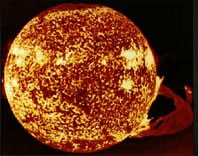Seems like an innocent enough question, right? Absolute zero is 0 on the Kelvin scale, or about minus 460 F. You can't get colder than that; it would be like trying to go south from the South Pole. Is there a corresponding maximum possible temperature?
Well, the answer, depending on which theoretical physicist you ask, is yes, no, or maybe. Huh? you ask. Yeah, that's how I felt. And the question doesn't just mess with the minds of physics dummies like me. Several physicists begged off of trying to answer it, referring me to colleagues. Even ones who did talk about it said things like "It's a little bit out of my comfort zone" and "I think I'd like to ruminate over it." After I posed it to one cosmologist, there was dead silence on the other end of the line for long enough that I wondered if we had a dropped call.
I had touched a nerve, because, unbeknownst to me, the highest-temperature question gets to the heart of current inquiries and proposed theories in cosmology and theoretical physics. Indeed, scientists who work in these fields are zealously trying to answer that question. Why? Because, in some sense, nothing less than the future course of physics rests on the answer.
Contender #1—1032 K
Certain cosmological models, including the one that has held sway for decades, the Standard Model, posit a theoretical highest temperature. It's called the Planck temperature, after the Austrian physicist Max Planck, and it equals about 100 million million million million million degrees, or 1032 Kelvin. "It's ridiculous is what it is," said Columbia physicist Arlin Crotts when I asked him if he could please put that number in perspective for me. "It's a billion billion times the largest temperature that we have to think about" (in gamma-ray bursts and quasars, for instance). Oh, that helped.
Truthfully, when contemplating the Planck temperature, you can forget perspective. All the usual terms for very hot—scorching, broiling, hellish, insert your favorite here—prove ludicrously inadequate. In short, saying 1032 K is hot is like saying the universe occupies some space. (For a game attempt at perspective, see A Sense of Scale.)
Whatever the highest temperature is, it might be essentially equivalent to the coldest temperature.
In conventional physics—that is, the kind that relies on Einstein's theory of general relativity to describe the very large and quantum mechanics to describe the very small—the Planck temperature was reached 10-43 seconds after the Big Bang got under way. At that instant, known as one Planck time, the entire universe is thought to have been the Planck length, or 10-35 meters. (In physics, Max Planck is the king of the eponymous.) An awfully high temperature in an awfully small space in an awfully short time after … well, after what? That's arguably an even bigger question—how did the universe begin?—and we won't go there.
A brick wall
The Planck temperature is the highest temperature in conventional physics because conventional physics breaks down at that temperature. Above 1032 K—that is, earlier than one Planck time—calculations show that strange things, unknown things, begin to happen to phenomena we hold near and dear, like space and time. Theory predicts that particle energies become so large that the gravitational forces between them become as strong as any other forces. That is, gravity and the other three fundamental forces of the universe—electromagnetism and the strong and weak nuclear forces—become a single unified force. Knowing how that happens, the so-called "theory of everything," is the holy grail of theoretical physics today.
"We do not know enough about the quantum nature of gravitation even to speculate intelligently about the history of the universe before this time," writes Nobel laureate Steven Weinberg about this up-against-a-brick-wall instant in his book The First Three Minutes. "Thus, whatever other veils may have been lifted, there is one veil, at a temperature of 1032 K, that still obscures our view of the earliest times." Until someone comes up with a widely accepted quantum theory of gravity, the Planck temperature, for conventional physicists like Steven Weinberg, will remain the highest temperature. Read

